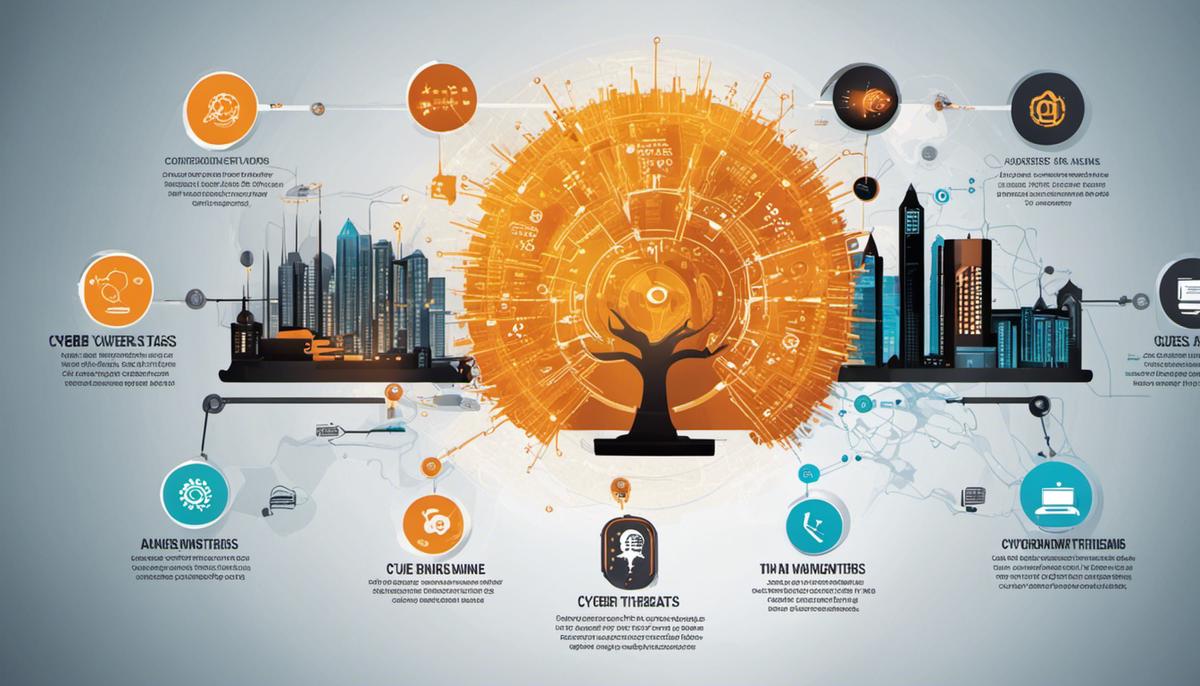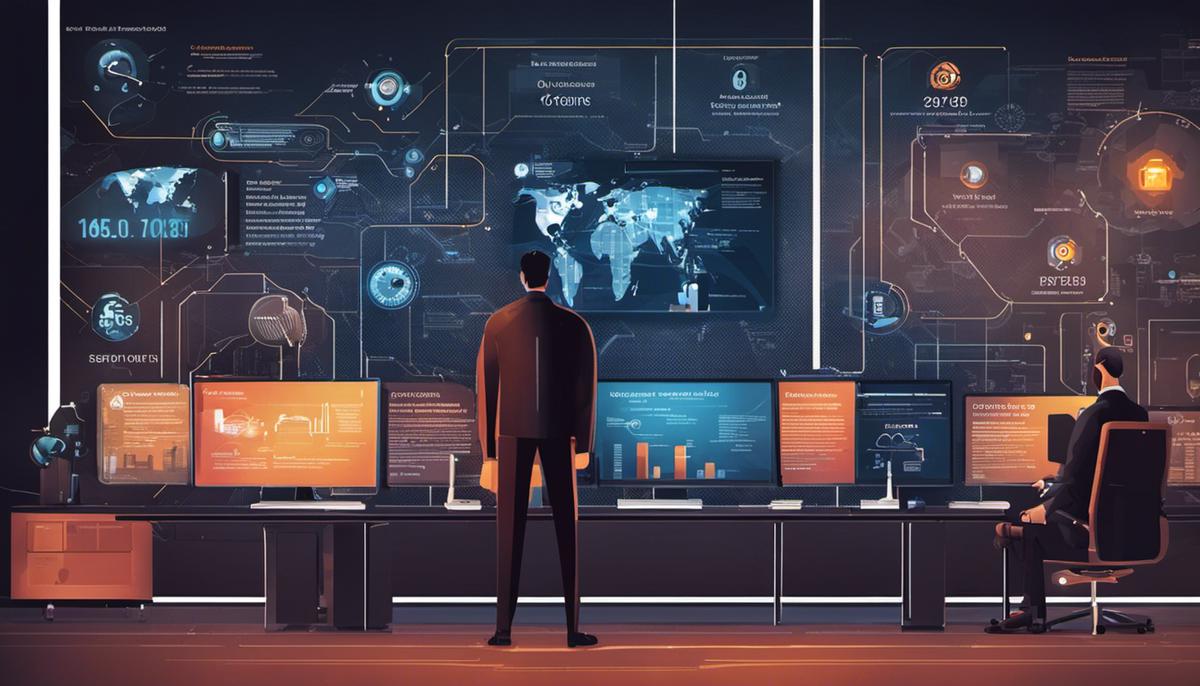In an increasingly digital landscape, the future of cybersecurity has become a paramount concern, shaping the present and future trajectory of individuals, businesses, and governments alike. The complex dynamic between cyber threats, emerging technologies, regulations, education, and future trends in cybersecurity forms the bedrock of our current discourse on the matter. The historical evolution of cyber threats presents a compelling narrative of the constant duel between security measures and the innovative yet malicious minds that navigate past them. Technologies and systems such as AI, ML, and facial recognition boast impressive potential for enhancing data protection and security levels. Nonetheless, their implementation demands meticulous supervision and regulation – a domain where laws such as GDPR and CCPA play a vital role. As we delve deeper into this multifaceted field, it is impossible to overlook the need for education and public awareness, which serve as the first line of defense against cyber threats.
The Evolution of Cyber Threats
Title: A Fascinating Journey Through the Evolution and Advancement of Cyber Threats
The digital space, while serving as a cornerstone for modern civilization, brings with it certain challenges. Among the most formidable of these is the increasing prevalence of cyber threats. The journey of cyber threats, from their genesis to their current forms, is an intriguing narrative of technological innovation mirroring criminal intent and sophistication.
In the nascent stages of the Internet, malicious cyber activities were largely confined to the actions of mischievous hackers. However, technologically simple yet disruptive, these initial threats were predominately basic viruses designed for minimal damage. One may recall the “Morris Worm” of 1988, considered one of the first cyber attacks, maze-like in its strategy, but pale in comparison to modern-day assaults.
By the early 2000s, we started witnessing the emergence of more evolved cyber threats, and the term “phishing” became common parlance. This marked the shift towards deceptive tactics, leveraging psychological manipulation to trick unsuspecting users into disclosing personal credentials. At the same time, distributed denial-of-service (DDoS) attacks began to surface, overpowering systems by flooding them with traffic from a multitude of compromised devices.
Fast-forward to the present era, the landscape of cyber threats has transformed dramatically. State-sponsored agents or criminal syndicates now commission sophisticated Advanced Persistent Threats (APTs). These persistent stealthy attacks infiltrate the system and dwell unnoticed over a prolonged period, causing profound damage to critical infrastructures.
Furthermore, the adoption of ransomware – sophisticated malware that locks down the victim’s files and demands a hefty ransom – has skyrocketed. The infamous WannaCry attack in 2017, which swept across nearly 150 countries, was a chilling testament to its destructive capabilities.
On another note, cyber threats are also evolving in response to the advent of artificial intelligence (AI) and machine learning technologies. These potent tools, while remarkably advancing cyber defenses, are paradoxically enabling adversaries to launch fast-paced, automated, and intelligent attacks.
And lastly, the concern rapidly extends to the burgeoning world of Internet of Things (IoT) devices. The projected 75.44 billion of these connected devices worldwide by 2025, if inadequately secured, can provide an unprecedented launchpad for distributed attacks.
Thereby, as elucidated, the evolution of cyber threats from innocuous malware to devastating APTs, ransomware, AI-enhanced attacks, and potential IoT-based threats unquestionably mirrors the exponential growth of our digital realm, urging an imperative need for robust and resilient cyber defenses. It was a fascinating journey indeed, but one we undertook out of necessity and not desire.

Emerging Technologies in Cybersecurity
As we continue to navigate an increasingly digital landscape, so too emerges a shifting paradigm in the cybersecurity domain. Innovations in technology are rendering traditional defensive measures somewhat obsolete, thus necessitating the exploration of novel methods and measures. Cybersecurity, accordingly, must evolve in parallel with these technological advancements to maintain equilibrium and to substantially mitigate the ever-expanding scope of digital threats.
The advent of quantum computing is spurring forward a new frontier in cybersecurity, a technology offering exponentially enhanced computational capabilities in comparison to existing binary computing systems. Quantum computing introduces a critical paradigm shift, promising to reinvent encryption systems currently used to secure data transmission. Our conventional encryption methods hinge on the infeasibility of factoring large prime numbers – a task quantum computers may accomplish far more easily, threatening to render existing encryption frameworks obsolete. Concurrently, quantum computing also introduces quantum key distribution, fuelling the potential for theoretically ‘unhackable’ cryptography systems. These developments underscore the dualistic nature of technological advances: the simultaneous presence of uplifting potential and latent threats.
Blockchain, too, has caused a stir in cybersecurity fields. It is a decentralized and distributed ledger technology that offers enhanced security and reliability for transactions. Though commonly associated with cryptocurrencies, its underlying technology has profound implications for cybersecurity. The blockchain’s structural integrity reduces the risk of data tampering, increases transparency, and ensures non-repudiation, thereby abating an array of cyber threats. Yet, it is also not immune to exploitation, and we are witnessing the advent of blockchain-specific malware and consensus hijacking attempts.
Artificial Intelligence (AI) and machine learning (ML) already boast preeminent roles within cybersecurity. While the potential of such technologies in cyber defense is immense, their role is quintessentially ambivalent. They facilitate enhanced threat detection and response but can also aid malicious hackers in expedited vulnerability identification and sophisticated attacks. Cybersecurity’s future must therefore grapple with the challenges posed by adversarial machine learning techniques, where AI systems are manipulated to cripple its defense capabilities.
These advanced technologies and their imminent implications for cybersecurity represent nothing less than the ongoing and evolving ‘arms race’ in our digital world. Quantum computing, blockchain, AI, and ML have the potential to reconfigure the cybersecurity landscape drastically, both challenging and invigorating cyber defense mechanisms. As specialists engaged in these dynamic and fascinating realms, our pursuit of knowledge and innovation must not only keep abreast but also take strides ahead to anticipate, defend, and control the risks associated with such rapid advancements. It is only through this fortress of knowledge that we will mitigate the cyber threats of tomorrow and keep the digital world secure.
Regulations and Compliance in Cybersecurity
In consideration of this burgeoning landscape of cyber threats, it becomes a necessity to explore how laws and regulations are evolving to tackle these increasingly complex cybersecurity challenges. Establishing cyber norms at the international level has emerged as an imperative, yet the heterogeneous nature of global internet governance poses significant hurdles.
One noteworthy step in this direction is the European General Data Protection Regulation (GDPR), which not only enhances personal data rights but also introduces strict penalties for compliance failure. This landmark regulation, intrinsically designed to fortify cybersecurity, underscores the need for strong data protection measures. While the U.S. has yet to enact a federal privacy law akin to GDPR, state-level initiatives like the California Consumer Privacy Act (CCPA) are encouraging.
Simultaneously, countries around the globe are enacting specific cybersecurity laws. For instance, China’s cybersecurity law broadly addresses data protection and network security, despite criticism regarding its potential impact on global companies and freedom of expression.
To effectively counter cyber attacks on critical infrastructure, several nations have initiated policies aimed at securing these vital assets. The U.S., for instance, has the Cybersecurity and Infrastructure Security Agency (CISA), an operational component under the Department of Homeland Security. The agency’s aim includes delivering comprehensive cybersecurity services aimed at protecting the country’s critical infrastructure.
Recognizing the unique vulnerabilities of IoT devices, the U.S. and the UK have both introduced legislation designed to enforce minimum security standards on IoT manufacturers. These laws represent a decisive stride in tackling the prevailing concerns around IoT security.
Moreover, understanding the significant national security implications posed by the widespread use of AIs, the U.S. has issued the National Artificial Intelligence Initiative Act, formulated to guide AI development and integration in line with national security interests. Concurrently, the Pentagon’s Joint Artificial Intelligence Center (JAIC) represents an effort toward constructing ethical norms and policies for military AI applications.
However, creating laws and regulations to keep abreast with cybersecurity dynamics is a Sisyphean task. The exponential growth of technology and the unprecedented shift towards a digital global order necessitates constant revision and refinement of these laws. In light of this, the active involvement of academia, industry, civil society, and governments in formulating cyber policies becomes imperative.
The ambit of regulatory frameworks for cybersecurity also involves understanding and addressing the potential risks of burgeoning technologies such as quantum computing and blockchain. Despite their promising attributes, lax oversight could provide malevolent entities with potent digital weapons, consequentially escalating the already complex cybersecurity scenario.
Finally, regulations must vigilantly weigh the ambivalent nature of AI and ML applications in cybersecurity. While these technologies undoubtedly amplify defensive mechanisms, they simultaneously arm threat actors with sophisticated attack tools.
To conclude, viewed through the lens of relentless digital evolution, the development of laws and regulations for cybersecurity remains dynamic and challenging. Rather than simply restricting activities deemed hazardous, the legal approach needs to be agile and comprehensive, promoting cooperation, fostering innovation, and encouraging responsible usage of advancing technologies.
Undeniably, the digital era is here to stay, and so are its challenges. Facing them head-on with comprehensive cyber laws and regulations stamps the first step towards creating a safer cyber realm for everyone.

Cybersecurity Education and Awareness
The current state of cybersecurity education and public awareness is preponderantly linked to the evolution of threats and the ever-changing technological landscape, yet remains somewhat lackluster in the face of growing digital complexity. While the digital age now demands an advanced level of cybersecurity competence even among non-technical individuals, the considerable knowledge gap observed may be attributed to a multifaceted blend of global institutional inertia, lack of accessibility to quality resources, and the rapidly developing nature of the cyber domain itself.
A crucial aspect of the cybersecurity equation is the general public’s awareness and understanding of cyber threats. Unmistakably, the level of public awareness of cyber threats has augmented over time, driven by increasing incidences of cyber-attacks that have caught the public’s attention. Nonetheless, understanding the intricacies of these threats remains an arduous task for the average Internet user. Indeed, even when awareness is high, behavior doesn’t necessarily follow suit, with many Internet users showcasing a notable ‘security fatigue’ against constant warnings of digital attacks.
The education sector, responsible for capacity building, is yet another critical player in this arena. Regrettably, even as the demand for cybersecurity professionals skyrockets, the formal educational establishment appears to be lagging in delivering cyber-secure savvy graduates. Notably, the teaching of cybersecurity has been historically viewed as a specialized sub-degree, leaving the majority of undergraduates with only a rudimentary understanding of cybersecurity best practices.
Where academia has yet to catch up, industry-related and private training providers have attempted to fill the skills deficit. The global appeal of prestigious, vendor-neutral certifications like Certified Information Systems Security Professional (CISSP), Certified Ethical Hacker (CEH), and Certified Information Security Manager (CISM) reflect an industry-wide attempt to escalate cybersecurity proficiency. While these initiatives provide individuals with a salient advantage in the job market, affordability, and accessibility can oftentimes present significant barriers.
The endeavors of governments and NGOs tasked with raising public awareness haven’t gone unnoticed. Campaigns to increase public knowledge of cybersecurity best practices, like the ‘Cyber Aware’ initiative in the UK or the ‘Stop. Think. Connect.’ initiative in the US has been instrumental in elevating public discourse. Nevertheless, such initiatives face the unenviable task of delivering complex, evolving messages to a non-technical audience grappling with information overload.
In essence, the overarching narrative of cybersecurity education and public awareness remains two-fold. On one hand, there is an increasing general awareness of the fact that cyber threats exist and their potential harms. On the other hand, the intricate specifics of dealing with those threats in a rapidly evolving digital landscape are a mountainous challenge for both individuals and institutions, albeit strains of improvement can be discerned. Consequently, comprehending the nature of cyber threats and the ongoing endeavors to arm people with appropriate defenses requires constant scrutiny and public dialogue.
The Future Trends in Cybersecurity
Our dialogue now turns to emerging trends on the future landscape of cybersecurity, with attention drawn to the advent of 5G and Edge Computing. The fifth-generation cellular network technology not only promises enhanced speed, bandwidth, and network capacity but also adds new dimensions to the cyber threat landscape. The increased number of devices and expanded network surface area could herald new opportunities for insecurity.
Edge Computing, a computational paradigm aimed at bringing data storage and computation closer to the location of use, could potentially increase exposure to cyber threats owing to the dispersal of data across multiple nodes. While it ameliorates issues of latency and bandwidth usage, circumventing severe security challenges must be at the vanguard of its progression.
Autonomous vehicles are poised to become commonplace as the Internet of Vehicles (IoV) evolves. While this development may offer increased convenience and efficiency, it concurrently opens up new frontiers for cyber threats. Mitigating the risk of cyber-attacks on what could easily become critical or even life-supporting transportation systems necessitates rigorous cybersecurity controls.
As the digital world interacts more intimately with the physical world, the focus on securing Industrial Control Systems (ICS) and Operational Technology (OT) becomes more pertinent. The potential for cyber threats to have real and immediate physical effects—from crippling breaches in utility systems to life-threatening assaults on health technologies—dramatically raises the stakes for effective cybersecurity.
Addressing cybersecurity in the Smart City paradigm, where multiple critical services and infrastructures are interconnected into one giant digital organism, is also on the horizon. Breaches in one sector have the potential to reverberate toward others, causing a cascade of failures emphasizing the immediate need for an entirely new approach to securing such ecosystems.
Lastly, the rise of Deepfake technology, which employs AI to fabricate convincing false images, sound, and videos, has the potential to exploit cyber vulnerabilities, disrupt public information dissemination, and generate disinformation campaigns. The urgent importance of computational systems capable of detecting and mitigating such deepfake attacks is as clear as it is challenging.
The shifting landscape described above underlines the realities of an ever-evolving arena, one where the complexities of cyber threats are interlinked with innovation and technological progress. In meeting this dynamic challenge head-on, the collaboration between sectors, the development of clear legislation, and effective education for all users remain top priorities.
Accepting the fact that no single solution offers a panacea for these problems, constantly adapting and increasing our understanding will give us the tools to turn the tide in this digital battleground. Remaining vigilant as new actors come to light in the arena of cybersecurity, staying ahead of these threats, and battling for the highest stakes are responsibilities shared among us all.

As we journey ahead in the intricate realm of cybersecurity, it becomes increasingly evident that our future will be shaped not merely by technological advancements but also by our understanding and aptitude to leverage them for security. In a digital age characterized by rapid shifts in technology, forensic cybersecurity, and threat intelligence will play a pivotal role in safeguarding our information resources and infrastructure. However, the final piece in this complex puzzle lies in our ability to promote cybersecurity education and awareness, fostering a culture of vigilance and adherence to protocols. Indeed, the future of cybersecurity presents a comprehensive canvas where technology, law, and human-centric approaches meld to ensure our collective digital safety in an interconnected world.

